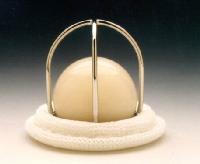| Medical Finals contents: Welcome Finals advice Written exams Clinical revision X-Rays Mock final OSCE's |  |
Medical Finals contents: Monthly quiz PDA's Links Credits Your comments Who are we? |
Question 1 | |||||
| Which of the following measures is not a poor prognostic indicator in patients with pneumonia? | |||||
| |||||
|
Answer: (b) Respiratory rate of 28 breaths per minute
The "CURB 65" score is a useful mnemonic for poor prognosis in patients with pneumonia. Prognosis is worst for patients who have many of the following:
|
Question 2 | |||||
The following picture is of a Star-Edwards mechanical heart valve

(Picture from: EMedicine) Which of the following medications should a patient with a mechanical heart valve be taking: | |||||
| |||||
|
Answer: (d) Warfarin aiming for an INR of 3.0
Mechanical valves are at significant risk of thrombus forming on them, even when coated with teflon. Such thrombus could embolise causing for example a CVA. To reduce this possibiliy patients should be on warfarin lifelong with INR of 3.0. Prophalytic antibiotic are needed only before and immediately after procedures involving possible entry of infection into blood stream, such as tooth removal, endoscopy, and most surgical procedures. Mechanical valves rarely suffer problems with rejection. In comparison bioprosthetic porcine tissue valves only need anticoagulation for the first 3 months. For more inforamtion see this eMedicine article on Prosthetic Heart Valves. |
Question 3 | |||||
| Which of the following is a feature of life threatening asthma? | |||||
| |||||
|
Answer: (d) Sinus bradycardia at 40 beats per minute
The guideline states that the following are features of acute severe asthma:
The following are listed as life threatening features:
Since a pulse rate of less than 60 beats per minute is bradycardia, this is the correct option. For more information on this topic you should refer to the British Guideline on the Management of Asthma published by the British Thoracic Society and Scottish Intercollegiate Guidelines Network. This guideline can be obtained via www.brit-thoracic.org.uk. |
Question 4 | ||||
| For patients with chronic obstructive pulmonary disease (COPD), which of the following is one of the true indications for consideration for long-term oxygen therapy (LTOT)? | ||||
| ||||
|
Answer: (c) PaO2 = 7.1 kPa when breathing 21% oxygen
In 2004 the National Institute for Clinical Excellence (NICE) produced a guideline entitled "Chronic Obstructive Pulmonary Disease: Management of chronic obstructive pulmonary disease in adults in primary and secondary care." This can be accessed via the following link: www.nice.org.uk/pdf/CG012_niceguideline.pdf. The guideline recommends that: "LTOT is indicated in patients with COPD who have a PaO2 less than 7.3 kPa when stable or a PaO2 greater than 7.3 and less than 8 kPa when stable and one of: secondary polycythaemia, nocturnal hypoxaemia (oxygen saturation of arterial blood [SpO2] less than 90% for more than 30% of time), peripheral oedema or pulmonary hypertension. To get the benefits of LTOT patients should breathe supplemental oxygen for at least 15 hours per day. Greater benefits are seen in patients receiving oxygen for 20 hours per day." Smoking in the presence of oxygen is a fire hazard. The partial pressures of oxygen referred to in the guideline relate to patients breathing 'room air' that is comprised of 21% oxygen. |
Question 5 | |||||
| Which of the following renal conditions is most strongly linked with pulmonary embolism? | |||||
| |||||
|
Answer: (e) Nephrotic syndrome
In nephrotic syndrome, protein is passed in the urine. The proteins lost include naturally occurring anti-clotting factors, and loss of these predisposes patients to thrombotic disorders particularly deep venous thrombosis and pulmonary embolism. |